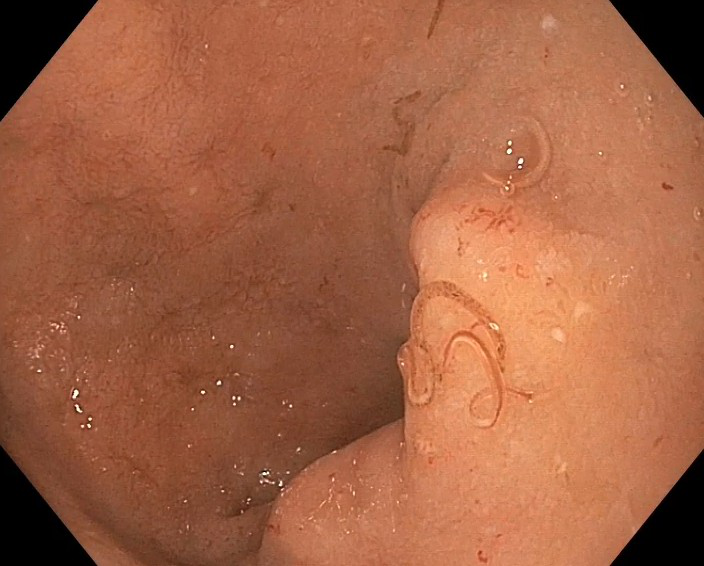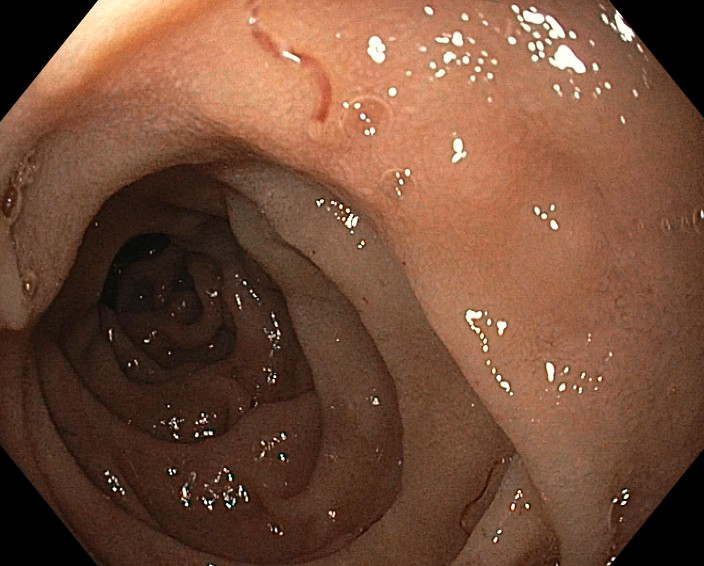Monday Poster Session
Category: General Endoscopy
P3028 - Endoscopy in the Diagnosis of Anemia
Monday, October 27, 2025
10:30 AM - 4:00 PM PDT
Location: Exhibit Hall

Vishal Pande, MBBS (he/him/his)
Krishna Institute of Medical Sciences
Hyderabad, Telangana, India
Presenting Author(s)
Vishal Deshpande, MBBS, Sethu Babu, MD, DM, K.A. Ramakrishna, MD, DM
Krishna Institute of Medical Sciences, Hyderabad, Telangana, India
Introduction: Iron deficiency anemia (IDA) persists as a worldwide health issue because it frequently develops from hidden gastrointestinal blood loss. Identifying the etiology becomes difficult when stool routine reports negative. Endoscopy functions as a vital diagnostic tool to visualize the upper GI tract directly for identifying bleeding sources in such cases. The case illustrates why endoscopic evaluation serves as an essential diagnostic method for determining the source of unclear IDA causes.
Case Description/
Methods: A 60-year-old farmer with severe IDA (Hb 4.4 g/dL) presented with fatigue, dyspnea, and anorexia. Initial stool microscopy was negative for ova or cysts and was positive for occult blood. Blood tests were negative for eosinophilia. Despite iron supplementation, anemia persisted. Esophagogastroduodenoscopy revealed translucent, blood-filled worms in the duodenum, later identified as hookworms. Albendazole and iron therapy improved her hemoglobin to 8.1 g/dL.
Discussion: Hookworm infection should be suspected as cause of IDA in endemic areas even when stool tests are negative because microscopy lacks sensitivity. The prevalence of parasitic infections is high in developing countries. The combination of anemia and malnutrition occurs in chronic parasitic infections, without triggering eosinophilia due to immune suppression. The prevalence of hookworm infection in India is in the range of 12.5% and 66% because of inadequate sanitation practices. Hookworms have been incidentally detected during endocopic evaluation in patients. The treatment of choice for hookworm infection is albendazole (400mg) or mebendazole (500mg) administered orally for 3 days for maximum effectiveness, with iron and nutritional support. WHO advocates deworming practices, sanitation improvements and education programs but fails to address zoonotic reservoirs. Programs that solely focus on human treatment will maintain the transmission cycle. Sustainable control requires integrated human-animal-environment strategies. This case demonstrates the necessity to suspect hookworm infection in IDA patients even when stool tests are negative and shows how prevention efforts fail to address zoonotic transmission. The control of soil-transmitted helminthiasis requires regular deworming programs together with veterinary interventions in areas where the disease is endemic and to prevent its long term morbidity calls for public health strategies that combine education with sanitation improvements and multisectoral collaboration.

Figure: Parasitic worm located in the descending part of the second part of duodenum.

Figure: Parasitic worms located in the ampullary region of the second part of duodenum.
Disclosures:
Vishal Deshpande indicated no relevant financial relationships.
Sethu Babu indicated no relevant financial relationships.
K.A. Ramakrishna indicated no relevant financial relationships.
Vishal Deshpande, MBBS, Sethu Babu, MD, DM, K.A. Ramakrishna, MD, DM. P3028 - Endoscopy in the Diagnosis of Anemia, ACG 2025 Annual Scientific Meeting Abstracts. Phoenix, AZ: American College of Gastroenterology.
Krishna Institute of Medical Sciences, Hyderabad, Telangana, India
Introduction: Iron deficiency anemia (IDA) persists as a worldwide health issue because it frequently develops from hidden gastrointestinal blood loss. Identifying the etiology becomes difficult when stool routine reports negative. Endoscopy functions as a vital diagnostic tool to visualize the upper GI tract directly for identifying bleeding sources in such cases. The case illustrates why endoscopic evaluation serves as an essential diagnostic method for determining the source of unclear IDA causes.
Case Description/
Methods: A 60-year-old farmer with severe IDA (Hb 4.4 g/dL) presented with fatigue, dyspnea, and anorexia. Initial stool microscopy was negative for ova or cysts and was positive for occult blood. Blood tests were negative for eosinophilia. Despite iron supplementation, anemia persisted. Esophagogastroduodenoscopy revealed translucent, blood-filled worms in the duodenum, later identified as hookworms. Albendazole and iron therapy improved her hemoglobin to 8.1 g/dL.
Discussion: Hookworm infection should be suspected as cause of IDA in endemic areas even when stool tests are negative because microscopy lacks sensitivity. The prevalence of parasitic infections is high in developing countries. The combination of anemia and malnutrition occurs in chronic parasitic infections, without triggering eosinophilia due to immune suppression. The prevalence of hookworm infection in India is in the range of 12.5% and 66% because of inadequate sanitation practices. Hookworms have been incidentally detected during endocopic evaluation in patients. The treatment of choice for hookworm infection is albendazole (400mg) or mebendazole (500mg) administered orally for 3 days for maximum effectiveness, with iron and nutritional support. WHO advocates deworming practices, sanitation improvements and education programs but fails to address zoonotic reservoirs. Programs that solely focus on human treatment will maintain the transmission cycle. Sustainable control requires integrated human-animal-environment strategies. This case demonstrates the necessity to suspect hookworm infection in IDA patients even when stool tests are negative and shows how prevention efforts fail to address zoonotic transmission. The control of soil-transmitted helminthiasis requires regular deworming programs together with veterinary interventions in areas where the disease is endemic and to prevent its long term morbidity calls for public health strategies that combine education with sanitation improvements and multisectoral collaboration.

Figure: Parasitic worm located in the descending part of the second part of duodenum.

Figure: Parasitic worms located in the ampullary region of the second part of duodenum.
Disclosures:
Vishal Deshpande indicated no relevant financial relationships.
Sethu Babu indicated no relevant financial relationships.
K.A. Ramakrishna indicated no relevant financial relationships.
Vishal Deshpande, MBBS, Sethu Babu, MD, DM, K.A. Ramakrishna, MD, DM. P3028 - Endoscopy in the Diagnosis of Anemia, ACG 2025 Annual Scientific Meeting Abstracts. Phoenix, AZ: American College of Gastroenterology.
